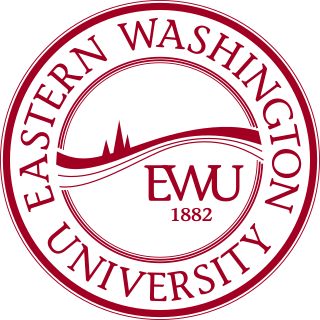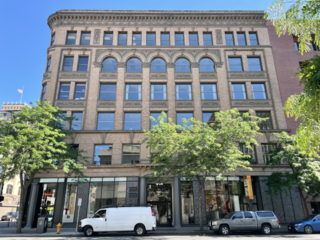
Lewis-Clark State College is a public college in Lewiston, Idaho, United States. It was founded 132 years ago in 1893 and has an approximate annual enrollment of 3,600. The college offers more than 130 degrees.

Cheney is a city in Spokane County, Washington, United States. The full-time resident population was 13,255 as of the 2020 census. Eastern Washington University is located in Cheney. When classes are in session at EWU, the city's population reaches approximately 17,600 people temporarily.

Eastern Washington University (EWU) is a public university in Cheney, Washington, United States. It shares its satellite campus in Spokane, Washington with Washington State University.

Alvin Victor "Honest Vic" Donahey was an American Democratic Party politician from Ohio. Donahey was the 50th governor of Ohio and a United States Senator from Ohio.

Cheney School District No. 360 is a public school district in Spokane County, Washington and serves the towns of Cheney, Airway Heights, and the surrounding area. The district offers classes from Kindergarten to Grade 12.

The EWU–UM Governors Cup is the college football rivalry game between the University of Montana Grizzlies and the Eastern Washington University Eagles, both members of the Big Sky Conference in the Football Championship Subdivision (FCS).

Hays Hall was a residence hall at Washington & Jefferson College. The architectural work was performed by Frederick J. Osterling and it was named after President George P. Hays. Construction was completed in 1903 and the new "fireproof" building was opened to Washington & Jefferson Academy students. Rooms were arranged in a suite style, with communal bathrooms on each floor, and shower baths on the 5th floor. In 1912, the Academy closed and Hays Hall was used by Washington & Jefferson College students. At various times, Hays Hall housed the bookstore and a dining hall. By 1968, Hays Hall had deteriorated to the point where it no longer able to house students, but the bookstore remained. In 1982, the building was declared a fire hazard and closed for all uses. While various efforts sought to renovate or restore Hays Hall, including a push to have it named a historical landmark, Hays Hall was demolished in 1994.
The Eastern Washington Eagles football team represents Eastern Washington University in the NCAA Division I Football Championship Subdivision. The Eastern Eagles are members of the Big Sky Conference and play at Roos Field, which is known for being the only stadium in college football with a red playing surface.

William James Sutton was an American politician in the state of Washington. He served in the Washington State Senate from 1913 to 1917 and 1921 to 1933. From 1931 to 1933, he was President pro tempore of the Senate.
William Bryan "Red" Reese was athletic director and coach of multiple sports at Eastern Washington University in Cheney from 1930 to 1964.
The 1891 State Normal School at Cheney fire was a conflagration on the morning of August 27, 1891, that consumed the only building then housing the State Normal School at Cheney in Cheney, Washington. There were no deaths, but the destruction of the building sparked a multi-year battle with the governor and state legislature regarding whether the normal school would be shuttered, or whether the state would authorize funds for the construction of a replacement building.
Chauncey B. Seaton was an architect in the United States. He was born near Bucyrus, Ohio, studied at Wooster University and then at a technical school in Chicago.
Mary Ann Monroe was a prominent teacher and school administrator in Spokane, Washington, and an active figure in education across the state of Washington. She was the first woman to serve as president of the Washington Education Association and the first woman on the board of trustees at the State Normal School at Cheney. She ran unsuccessfully for the office of Washington Superintendent of Public Instruction in 1912, but was active in civic and state politics in the early 20th century.
The Cheney Free Press has been the dominant newspaper of Cheney in the U.S. state of Washington since its inception in 1896. It was not the first newspapers there; the North-West Tribune was published in Cheney from June 1880 to about 1886, and was the second in Spokane County.
Eleanor Barrow Chase was an American social worker and civic leader in Spokane, Washington. She was particularly active in organizations devoted to young people and to education, and was the first African American woman on the board of trustees at Eastern Washington University, where she was instrumental in securing EWU's admission as a member of the Big Sky Conference in 1987. She also served on the board of trustees at Whitworth College.

The Empire State Building, also known as the Great Western Savings and Loan Building, is a historic building in Downtown, Spokane, Washington. It was designed by architect John K. Dow, and built in 1899 for Charles Sweeny, an investor who had served under Union Army General George Armstrong Custer during the American Civil War of 1861–1865. It has been listed on the National Register of Historic Places since August 18, 1977.
The Associated Students of Eastern Washington University (ASEWU) is the student government for the undergraduate and graduate student body at Eastern Washington University (EWU). The organization was first established in what was then the State Normal School at Cheney when its constitution was approved for the 1919–1920 academic year, and its initial class of officers were elected. ASEWU has played an important role in the life and landscape of EWU, including raising funds for multiple student union building projects over the course of the 20th and early 21st centuries.
The Great Northern School District No. 312 is a school district in Spokane County, Washington, United States. It covers a rural unincorporated area between Airway Heights and Spokane and has a single school, named Great Northern Elementary, that serves grades kindergarten to six.
Cheney High School is a four-year public high school in Cheney, Washington, United States serving the Cheney School District. The school has a population of 1,300 students in grades 9–12, with more than 70 full-time equivalent teaching staff. Cheney athletic teams compete in the Greater Spokane League as the Blackhawks, and the school colors are red and black.
The 1913 Cheney Normal football team represented the State Normal School at Cheney—now known as Eastern Washington University—as an independent during the 1913 college football season. Led by first-year head coach Albert Fertsch, Cheney Normal compiled a record of 1–5.